| Listing 1 - 10 of 11 | << page >> |
Sort by
|
Dissertation
ISBN: 9056826964 Year: 2006 Publisher: Leuven Katholieke Universiteit Leuven
Abstract | Keywords | Export | Availability | Bookmark
 Loading...
Loading...Choose an application
- Reference Manager
- EndNote
- RefWorks (Direct export to RefWorks)
Dit proefschrift beschrijft de ontwikkeling van golfgebaseerde modelleringstechnieken voor het analyseren van stationaire vibro-akoestische problemen. Vaak worden klassieke elementgebaseerde methoden, zoals de eindige-elementenmethode (EEM) en de randelementenmethode (REM), toegepast voor de analyse van dit type van problemen. De toepasbaarheid van de elementgebaseerde methoden is echter beperkt tot het laagfrequente gebied. De golfgebaseerde methode (GBM) is een alternatieve methode die gebaseerd is op een indirecte Trefftz benadering. De GBM is rekenkundig zeer efficiënt, waardoor de methode ook toepasbaar is voor het analyseren van problemen bij hogere frequenties. Dit proefschrift rapporteert over de ontwikkeling van een uitbreiding van de GBM voor het behandelen van akoestische problemen bestaande uit meerdere subdomeinen en voor het analyseren van problemen in oneindige fluïda. De efficiëntie van de GBM is het meest uitgesproken voor problemen met een bescheiden geometrische complexiteit. Een hybride eindige-elementen-golfgebaseerde methode combineert de sterke punten van de twee technieken, namelijk de hoge rekenkundige efficiëntie van de GBM en de toepasbaarheid van de EEM voor problemen met een willekeurige geometrische complexiteit. Numerieke validatievoorbeelden tonen het verhoogde prestatievermogen aan van zowel de uitgebreide GBM voor problemen met een bescheiden geometrische complexiteit, als van de hybride methode voor levensechte ingenieurstoepassingen. This dissertation considers the development of wave based prediction methods for the analysis of steady-state vibro-acoustic problems. Conventional element based prediction methods, such as the finite element method (FEM), are commonly used, but are restricted to low-frequency applications. The wave based method (WBM) is an alternative deterministic technique which is based on the indirect Trefftz approach. The WBM is computationally very efficient, allowing the analysis of problems at higher frequencies. This dissertation reports on an extension of the WBM to multi-domain acoustic problems and problems involving unbounded acoustic fluid domains, such as transmission, scattering and radiation problems. The efficiency of the WBM is most pronounced for problems of moderate geometrical complexity. A hybrid finite element-wave based method combines the strengths of the two methods, namely, the high computational efficiency of the WBM and the ability of the FEM to model problems of arbitrary geometrical complexity. Numerical validation examples show the enhanced computational efficiency of the WBM for problems of moderate geometrical complexity and of the hybrid method for real-life engineering problems. De steeds strenger wordende wettelijke reglementeringen inzake menselijke blootstelling aan trillingen en lawaai en de steeds hogere comforteisen van hun klanten zijn de twee belangrijkste redenen waarom fabrikanten meer en meer belang hechten aan het verbeteren van het trillings- en lawaai-opwekkende gedrag van hun producten. Om dit zogenaamde vibro-akoestische gedrag op een goedkope en efficiënte manier te bestuderen en te verbeteren, wordt in een moderne ontwerpomgeving steeds vaker gebruik gemaakt van computermodellen. Met deze computermodellen kan een ontwerpingenieur voorspellen hoeveel lawaai en hoeveel trillingen zijn product zal veroorzaken. De technieken die momenteel bestaan om zulke computermodellen te maken, zijn echter niet altijd bruikbaar en leveren niet altijd alle gewenste informatie. Daarom zijn er in dit doctoraatswerk nieuwe technieken ontwikkeld die de beperkingen van de bestaande technieken voor een groot deel opheffen. Hierdoor kunnen computermodellen nog efficiënter gebruikt worden bij het voorspellen en verbeteren van het vibro-akoestische gedrag van een product.
Academic collection --- 681.3*G18 <043> --- 534 <043> --- 534 <043> Vibrations. Acoustics--Dissertaties --- Vibrations. Acoustics--Dissertaties --- 681.3*G18 <043> Partial differential equations: difference methods; elliptic equations; finite element methods; hyperbolic equations; method of lines; parabolic equations (Numerical analysis)--Dissertaties --- Partial differential equations: difference methods; elliptic equations; finite element methods; hyperbolic equations; method of lines; parabolic equations (Numerical analysis)--Dissertaties --- Theses
Dissertation
ISBN: 9056826786 Year: 2006 Publisher: Heverlee Katholieke Universiteit Leuven. Faculteit Ingenieurswetenschappen
Abstract | Keywords | Export | Availability | Bookmark
 Loading...
Loading...Choose an application
- Reference Manager
- EndNote
- RefWorks (Direct export to RefWorks)
Tijdsafhankelijke partiële differentiaalvergelijkingen worden numeriek opgelost door zowel tijd als ruimte te discretiseren. Omdat de zo bekomen stelsels van vergelijkingen erg groot kunnen zijn, is het vaak nodig iteratieve methodes te gebruiken die de structuur van deze systemen uitbuiten. Voor gediscretiseerde parabolische problemen zijn multiroostermethodes een uitstekende keuze. Een typisch modelprobleem is de warmtevergelijking gediscretiseerd met eindige differenties of eindige elementen in de ruimte en met een lineaire multistapmethode in de tijd. We onderzoeken hoe multiroostertechnieken kunnen toegepast worden voor meer algemene tijdsafhankelijke problemen. In het bijzonder ontwikkelen we multiroostermethodes voor anisotrope problemen, tijdsdiscretisaties van hoge orde en problemen met vertraging. Verder stellen we ook een nieuwe werkwijze voor om de convergentie van multiroostermethodes voor tijdsafhankelijke partiële differentiaalvergelijkingen te analyseren. Anisotrope partiële differentiaalvergelijkingen hebben coëfficiënten met een sterke richtingsafhankelijkheid. Voor zulke problemen werken standaard multiroostermethodes niet goed. Uitgaande van de technieken voor stationaire anisotrope problemen ontwikkelen we efficiënte multiroostermethodes voor tijdsafhankelijke anisotrope problemen. We beschouwen methodes gebaseerd op lijnrelaxatie, semivergroving en meervoudige semivergroving. We passen dezelfde methodes ook met goede resultaten toe op diffusievergelijkingen met coëfficiënten die afhangen van zowel positie als richting. Impliciete Runge-Kuttamethodes, randwaardemethodes en algemene lineaire methodes zijn krachtige tijdsdiscretisatieschema's die nauwkeurigheid van hoge orde, goede stabiliteit en vele andere gunstige eigenschappen toelaten. Voor algemene tijdsafhankelijke problemen zijn de resulterende systemen van vergelijkingen echter moeilijker op te lossen dan bij lineaire multistapmethodes. We tonen aan dat voor gediscretiseerde parabolische problemen, erg efficiënte multiroostermethodes ontwikkeld kunnen worden. De stabiliteit van de tijdsdiscretisatieschema's blijkt erg belangrijk voor de convergentie van de iteratieve methodes. Dezelfde technieken worden gebruikt om de combinatie van iteratieve methodes en Chebyshev spectrale collocatie in de tijd te bestuderen. Bij gewone tijdsafhankelijke partiële differentiaalvergelijkingen hangt de verandering van de toestand op een bepaald moment enkel af van de huidige toestand van het systeem. Bij partiële differentiaalvergelijkingen met vertraging hangt de toestandsverandering ook af van toestanden in het verleden. We bestuderen iteratieve methodes voor diffusievergelijkingen met een extra term met een vaste vertraging. In al deze gevallen wordt het gedrag van de methodes beoordeeld met een theoretische convergentieanalyse en met numerieke experimenten. De theoretische analyses combineren de theorie van convolutieoperatoren en Laplacetransformaties voor tijdsafhankelijke problemen met technieken gebaseerd op Fouriermodes voor multiroostermethodes. We introduceren een nieuwe aanpak voor de spectrale analyse van iteratieve methodes gebaseerd op functionele calculus. Deze theorie omvat de Laplaceanalyse voor tijdsafhankelijke problemen en de Fourieranalyse voor multiroostermethodes. Time-dependent partial differential equations are solved numerically by discretizing both space and time. Since the resulting systems of equations can be very large, it is often necessary to use iterative methods that exploit the structure of these systems. For discretized parabolic problems multigrid methods are a particularly good choice. A typical model problem is the heat equation, discretized using finite differences or finite elements in space and a linear multistep method in time. We investigate here how multigrid techniques can be used for more general time-dependent problems. In particular we develop multigrid methods for anisotropic problems, high order time discretizations and problems with delay. Furthermore, we propose a new framework for the convergence analysis of multigrid methods for time-dependent partial differences equations. Anisotropic partial differential equations have coefficients with a strong directional dependency. For such problems standard multigrid methods break down. By extending the techniques for stationary anisotropic problems, we develop efficient multigrid methods for time-dependent anisotropic problems. We consider methods based on line relaxation, semicoarsening and multiple semicoarsening. The same methods are also applied with good results to diffusion equations with coefficients that depend on position as well as direction. Implicit Runge-Kutta methods, boundary value methods and general linear methods are powerful time discretization schemes providing high order accuracy, good stability and many other desirable properties. For general time-dependent problems, however, the resulting systems of equations are harder to solve than the ones for linear multistep methods. We show that for discretized parabolic problems, very efficient multigrid methods can be developed. The stability of the time discretization schemes turns out to be very important for the convergence of the iterative methods. The same techniques are used to study iterative methods in combination with Chebyshev spectral collocation in time. For standard time-dependent partial differential equations, the change of state at a certain time only depends on the current state of the system. For delay partial differential equations, the change of state also depends on the state of the system at times in the past. We study iterative methods for diffusion equations with one extra term with a fixed delay. In all these cases the performance of the methods is assessed with a theoretical convergence analysis and numerical experiments. The theoretical analyses combine the theory of Volterra convolution operators and Laplace transforms for time-dependent problems and Fourier mode techniques for multigrid. We propose a new approach for the spectral analysis of iterative methods based on functional calculus. This theory unifies the Laplace analysis for time-dependent problems and the Fourier analysis of multigrid methods.
681.3*G18 <043> --- 519.63 <043> --- Academic collection --- 519.63 <043> Numerical methods for solution of partial differential equations--Dissertaties --- Numerical methods for solution of partial differential equations--Dissertaties --- 681.3*G18 <043> Partial differential equations: difference methods; elliptic equations; finite element methods; hyperbolic equations; method of lines; parabolic equations (Numerical analysis)--Dissertaties --- Partial differential equations: difference methods; elliptic equations; finite element methods; hyperbolic equations; method of lines; parabolic equations (Numerical analysis)--Dissertaties --- Theses
Dissertation
ISBN: 9056827235 Year: 2006 Publisher: Leuven Katholieke Universiteit Leuven
Abstract | Keywords | Export | Availability | Bookmark
 Loading...
Loading...Choose an application
- Reference Manager
- EndNote
- RefWorks (Direct export to RefWorks)
Voor een belangrijke klasse meerschalige problemen bestaat er een scheiding van schalen tussen het beschikbare (microscopische) model en het (macroscopische) niveau waarop we het systeem wensen te bestuderen. Voor tijdsafhankelijke meerschalige problemen van dit type hebben Kevrekidis et al. een zogenaamd ``vergelijkingsvrij" raamwerk opgesteld, gebaseerd op het idee van een ``macroscopische tijdstapper". Wij bestuderen in dit raamwerk methodes die een ongekende macroscopische parti"ele differentiaalvergelijking kunnen benaderen aan de hand van gepast ge"initialiseerde microscopische simulaties in een aantal kleine deelgebieden van het ruimte-tijddomein. De bekomen methode is veel effici"enter dan een directe simulatie met het microscopische model. We analyseren, zowel theoretisch als met numerieke experimenten, het gedrag van de methode. Op basis van deze analyse stellen we verschillende verbeteringen voor. We tonen ook hoe we de bekomen tijdstapper kunnen gebruiken voor de analyse van bijvoorbeeld lange-termijnevenwichten. Tenslotte bespreken we een aantal experimenten waarbij het microscopische model stochastisch is. For an important class of multiscale problems, a separation of scales exists between the available (microscopic) model and the (macroscopic) level at which one would like to observe and analyze the system. For time-dependent multiscale problems of this type, Kevrekidis et al. developed a so-called ``equation-free'' framework, based on the idea of a so-called coarse-grained time-stepper. The patch dynamics scheme is a coarse-grained time-stepper which approximates the time evolution of a set of spatially distributed macroscopic variables for which the governing partial differential equation (PDE) is not (or only approximately) available; the scheme only performs appropriately initialized simulations using the available microscopic model in small portions of the space-time domain (the patches). We analyze the patch dynamics scheme for a class of parabolic homogenization problems. We show that the scheme approximates a finite difference scheme for the unavailable macroscopic equation when suitable boundary constraints are imposed on the microscopic simulations. Since this is generally not possible in practice, we introduce a modified scheme, which uses buffer regions around the patches. This allows to impose standard boundary conditions without affecting the microscopic solution inside the patches. We prove convergence for diffusion homogenization problems, and show numerically that the scheme can also be used for hyperbolic and higher order problems. We also formulate and analyze a finite volume variant for hyperbolic problems. Once a coarse-grained time-stepper has been constructed, it can readily be used as input for time-stepper based numerical bifurcation algorithms. We construct a Newton--GMRES method for the coarse-grained computation of travelling waves of lattice Boltzmann models. We accelerate the convergence of the GMRES iterations by means of a preconditioner, which is based on an approximate macroscopic PDE. We conclude with some numerical experiments in which the microscopic model is a stochastic particle-based model. We show that, in this case, one can only obtain accurate results when appropriate variance reduction techniques are used. This issue will require further investigation. Voor een belangrijke klasse meerschalige problemen bestaat er een scheiding van schalen tussen het beschikbare (microscopische) model en het (macroscopische) niveau waarop we het systeem wensen te bestuderen. Voor tijdsafhankelijke meerschalige problemen van dit type hebben Kevrekidis et al. een zogenaamd ``vergelijkingsvrij" raamwerk opgesteld, gebaseerd op het idee van een ``macroscopische tijdstapper". Wij bestuderen in dit raamwerk methodes die een ongekende macroscopische parti"ele differentiaalvergelijking kunnen benaderen aan de hand van gepast ge"initialiseerde microscopische simulaties in een aantal kleine deelgebieden van het ruimte-tijddomein. De bekomen methode is veel effici"enter dan een directe simulatie met het microscopische model. We analyseren, zowel theoretisch als met numerieke experimenten, het gedrag van de methode. Op basis van deze analyse stellen we verschillende verbeteringen voor. We tonen ook hoe we de bekomen tijdstapper kunnen gebruiken voor de analyse van bijvoorbeeld lange-termijnevenwichten. Tenslotte bespreken we een aantal experimenten waarbij het microscopische model stochastisch is. For an important class of multiscale problems, a separation of scales exists between the available (microscopic) model and the (macroscopic) level at which one would like to observe and analyze the system. For time-dependent multiscale problems of this type, Kevrekidis et al.~developed a so-called ``equation-free'' framework, based on the idea of a so-called coarse-grained time-stepper. In this framework, we study methods that allow to approximate an unavailable macroscopic partial differential equation, using only appropriately initialized microscopic simulations in a number of small regions in the space-timedomain (the patches). The resulting method is much more efficient than a straightforward simulation using the microscopic model. We analyse the behaviour of the method, both theoretically and with numerical experiments. Based on this analysis, we suggest a number of improvements. We also show how one can use this scheme to study long-term equilibria directly, en conclude with some experiments in which the microscopic model is stochastic.
Academic collection --- 519.63 <043> --- 681.3*I6 <043> --- 681.3*G18 <043> --- Numerical methods for solution of partial differential equations--Dissertaties --- Simulation and modeling (Computing methodologies)--See also {681.3*G3}--Dissertaties --- Partial differential equations: difference methods; elliptic equations; finite element methods; hyperbolic equations; method of lines; parabolic equations (Numerical analysis)--Dissertaties --- Theses --- 681.3*G18 <043> Partial differential equations: difference methods; elliptic equations; finite element methods; hyperbolic equations; method of lines; parabolic equations (Numerical analysis)--Dissertaties --- 681.3*I6 <043> Simulation and modeling (Computing methodologies)--See also {681.3*G3}--Dissertaties --- 519.63 <043> Numerical methods for solution of partial differential equations--Dissertaties
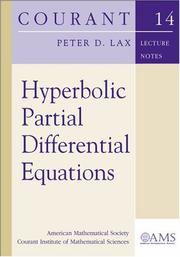
ISBN: 9780821835760 0821835769 Year: 2006 Publisher: New York Courant Institute of Mathematical Sciences American Mathematical Society
Abstract | Keywords | Export | Availability | Bookmark
 Loading...
Loading...Choose an application
- Reference Manager
- EndNote
- RefWorks (Direct export to RefWorks)
Differential equations, Hyperbolic. --- Equations différentielles hyperboliques --- Differential equations, Hyperbolic --- 517.95 --- 519.63 --- 681.3 *G18 --- Hyperbolic differential equations --- Differential equations, Partial --- 681.3 *G18 Partial differential equations: difference methods; elliptic equations; finite element methods; hyperbolic equations; method of lines; parabolic equations (Numerical analysis) --- Partial differential equations: difference methods; elliptic equations; finite element methods; hyperbolic equations; method of lines; parabolic equations (Numerical analysis) --- 519.63 Numerical methods for solution of partial differential equations --- Numerical methods for solution of partial differential equations --- 517.95 Partial differential equations --- Partial differential equations
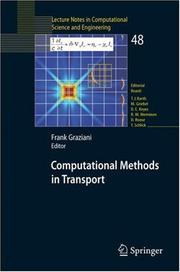
ISBN: 1280461446 9786610461448 3540281258 3540281223 Year: 2006 Publisher: Berlin, Heidelberg : Springer Berlin Heidelberg : Imprint: Springer,
Abstract | Keywords | Export | Availability | Bookmark
 Loading...
Loading...Choose an application
- Reference Manager
- EndNote
- RefWorks (Direct export to RefWorks)
There exist a wide range of applications where a significant fraction of the momentum and energy present in a physical problem is carried by the transport of particles. Depending on the specific application, the particles involved may be photons, neutrons, neutrinos, or charged particles. Regardless of which phenomena is being described, at the heart of each application is the fact that a Boltzmann like transport equation has to be solved. The complexity, and hence expense, involved in solving the transport problem can be understood by realizing that the general solution to the 3D Boltzmann transport equation is in fact really seven dimensional: 3 spatial coordinates, 2 angles, 1 time, and 1 for speed or energy. Low-order approximations to the transport equation are frequently used due in part to physical justification but many in cases, simply because a solution to the full transport problem is too computationally expensive. An example is the diffusion equation, which effectively drops the two angles in phase space by assuming that a linear representation in angle is adequate. Another approximation is the grey approximation, which drops the energy variable by averaging over it. If the grey approximation is applied to the diffusion equation, the expense of solving what amounts to the simplest possible description of transport is roughly equal to the cost of implicit computational fluid dynamics. It is clear therefore, that for those application areas needing some form of transport, fast, accurate and robust transport algorithms can lead to an increase in overall code performance and a decrease in time to solution.
Neutron transport theory --- Photon transport theory --- Radiative transfer --- Transport theory --- Research. --- Boltzmann transport equation --- Transport phenomena --- Mathematical physics --- Particles (Nuclear physics) --- Radiation --- Statistical mechanics --- Transfer, Radiative --- Astrophysics --- Geophysics --- Heat --- Multigroup diffusion (Neutron transport) --- Neutron diffusion theory --- Nuclear fission --- Nuclear fusion --- Nuclear reactors --- Radiation and absorption --- 517.95 --- 519.63 --- 681.3 *G18 --- 519.63 Numerical methods for solution of partial differential equations --- Numerical methods for solution of partial differential equations --- 517.95 Partial differential equations --- Partial differential equations --- 681.3 *G18 Partial differential equations: difference methods; elliptic equations; finite element methods; hyperbolic equations; method of lines; parabolic equations (Numerical analysis) --- Partial differential equations: difference methods; elliptic equations; finite element methods; hyperbolic equations; method of lines; parabolic equations (Numerical analysis) --- Research --- Computer science. --- Computational Science and Engineering. --- Theoretical, Mathematical and Computational Physics. --- Astrophysics and Astroparticles. --- Informatics --- Science --- Computer mathematics. --- Mathematical physics. --- Astrophysics. --- Astronomical physics --- Astronomy --- Cosmic physics --- Physics --- Physical mathematics --- Computer mathematics --- Electronic data processing --- Mathematics
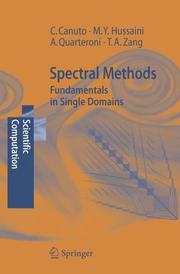
ISBN: 3540307257 3642068006 9786611341138 1281341134 3540307265 Year: 2006 Publisher: Berlin Springer
Abstract | Keywords | Export | Availability | Bookmark
 Loading...
Loading...Choose an application
- Reference Manager
- EndNote
- RefWorks (Direct export to RefWorks)
Differential equations, Partial --- Numerical analysis. --- Spectral theory (Mathematics). --- Numerical solutions. --- Numerical analysis --- Spectral theory (Mathematics) --- 517.2 --- 519.63 --- 535.33 --- 681.3*G18 --- 519.63 Numerical methods for solution of partial differential equations --- Numerical methods for solution of partial differential equations --- 535.33 Spectra in general. Emission spectra --- Spectra in general. Emission spectra --- 517.2 Differential calculus. Differentiation --- Differential calculus. Differentiation --- Functional analysis --- Hilbert space --- Measure theory --- Transformations (Mathematics) --- Mathematical analysis --- Numerical solutions --- Partitial differential equations: domain decomposition methods; elliptic equations; finite difference methods; finite element methods; finite volume methods; hyperbolic equations; inverse problems; iterative solution techniques; methods of lines; multigrid and multilevel methods; parabolic equations; special methods
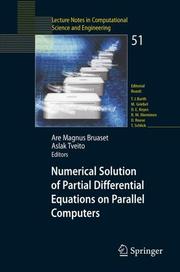
ISBN: 1280607920 9786610607921 3540316191 3540290761 Year: 2006 Publisher: Berlin, Heidelberg : Springer Berlin Heidelberg : Imprint: Springer,
Abstract | Keywords | Export | Availability | Bookmark
 Loading...
Loading...Choose an application
- Reference Manager
- EndNote
- RefWorks (Direct export to RefWorks)
Since the dawn of computing, the quest for a better understanding of Nature has been a driving force for technological development. Groundbreaking achievements by great scientists have paved the way from the abacus to the supercomputing power of today. When trying to replicate Nature in the computer’s silicon test tube, there is need for precise and computable process descriptions. The scienti?c ?elds of Ma- ematics and Physics provide a powerful vehicle for such descriptions in terms of Partial Differential Equations (PDEs). Formulated as such equations, physical laws can become subject to computational and analytical studies. In the computational setting, the equations can be discreti ed for ef?cient solution on a computer, leading to valuable tools for simulation of natural and man-made processes. Numerical so- tion of PDE-based mathematical models has been an important research topic over centuries, and will remain so for centuries to come. In the context of computer-based simulations, the quality of the computed results is directly connected to the model’s complexity and the number of data points used for the computations. Therefore, computational scientists tend to ?ll even the largest and most powerful computers they can get access to, either by increasing the si e of the data sets, or by introducing new model terms that make the simulations more realistic, or a combination of both. Today, many important simulation problems can not be solved by one single computer, but calls for parallel computing.
Differential equations, Partial --- Parallel processing (Electronic computers) --- Numerical solutions --- Data processing. --- 519.63 --- 681.3 *G18 --- Partial differential equations --- 681.3 *G18 Partial differential equations: difference methods; elliptic equations; finite element methods; hyperbolic equations; method of lines; parabolic equations (Numerical analysis) --- Partial differential equations: difference methods; elliptic equations; finite element methods; hyperbolic equations; method of lines; parabolic equations (Numerical analysis) --- 519.63 Numerical methods for solution of partial differential equations --- Numerical methods for solution of partial differential equations --- High performance computing --- Multiprocessors --- Parallel programming (Computer science) --- Supercomputers --- Numerical solutions&delete& --- Data processing --- Global analysis (Mathematics). --- Computer science. --- Computer science --- Differential equations, partial. --- Analysis. --- Computational Science and Engineering. --- Computational Mathematics and Numerical Analysis. --- Mathematics of Computing. --- Theoretical, Mathematical and Computational Physics. --- Partial Differential Equations. --- Mathematics. --- Computer mathematics --- Discrete mathematics --- Electronic data processing --- Informatics --- Science --- Analysis, Global (Mathematics) --- Differential topology --- Functions of complex variables --- Geometry, Algebraic --- Mathematics --- Mathematical analysis. --- Analysis (Mathematics). --- Computer mathematics. --- Computer science—Mathematics. --- Mathematical physics. --- Partial differential equations. --- 517.1 Mathematical analysis --- Mathematical analysis --- Physical mathematics --- Physics
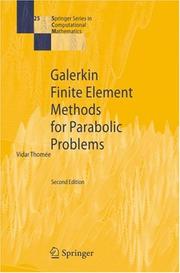
ISBN: 9783540331216 3540331212 3540632360 3642069673 9786610935710 1280935715 3540331220 3662033615 3662033593 Year: 2006 Volume: 25 Publisher: Berlin, Heidelberg : Springer Berlin Heidelberg : Imprint: Springer,
Abstract | Keywords | Export | Availability | Bookmark
 Loading...
Loading...Choose an application
- Reference Manager
- EndNote
- RefWorks (Direct export to RefWorks)
This book provides insight in the mathematics of Galerkin finite element method as applied to parabolic equations. The approach is based on first discretizing in the spatial variables by Galerkin's method, using piecewise polynomial trial functions, and then applying some single step or multistep time stepping method. The concern is stability and error analysis of approximate solutions in various norms, and under various regularity assumptions on the exact solution. The book gives an excellent insight in the present ideas and methods of analysis. The second edition has been influenced by recent progress in application of semigroup theory to stability and error analysis, particulatly in maximum-norm. Two new chapters have also been added, dealing with problems in polygonal, particularly noncovex, spatial domains, and with time discretization based on using Laplace transformation and quadrature.
519.63 --- 681.3 *G18 --- Differential equations, Parabolic --- -Finite element method --- 681.3 *G18 Partial differential equations: difference methods; elliptic equations; finite element methods; hyperbolic equations; method of lines; parabolic equations (Numerical analysis) --- Partial differential equations: difference methods; elliptic equations; finite element methods; hyperbolic equations; method of lines; parabolic equations (Numerical analysis) --- 519.63 Numerical methods for solution of partial differential equations --- Numerical methods for solution of partial differential equations --- FEA (Numerical analysis) --- FEM (Numerical analysis) --- Finite element analysis --- Numerical analysis --- Isogeometric analysis --- Parabolic differential equations --- Parabolic partial differential equations --- Differential equations, Partial --- Numerical solutions --- Finite element method --- 517 --- 519.6 --- 519.6 Computational mathematics. Numerical analysis. Computer programming --- Computational mathematics. Numerical analysis. Computer programming --- 517 Analysis --- Analysis --- Finite element method. --- Numerical solutions. --- Galerkin methods. --- Partial differential equations --- Equations différentielles paraboliques --- Méthode des éléments finis --- Solutions numériques --- Numerical analysis. --- Global analysis (Mathematics). --- Numerical Analysis. --- Analysis. --- Theoretical, Mathematical and Computational Physics. --- Analysis, Global (Mathematics) --- Differential topology --- Functions of complex variables --- Geometry, Algebraic --- Mathematical analysis --- Mathematical analysis. --- Analysis (Mathematics). --- Mathematical physics. --- Physical mathematics --- Physics --- 517.1 Mathematical analysis --- Mathematics
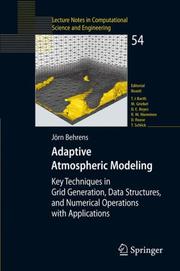
ISBN: 1280949341 9786610949342 3540333835 3540333827 Year: 2006 Volume: 52 Publisher: Berlin, Heidelberg : Springer Berlin Heidelberg : Imprint: Springer,
Abstract | Keywords | Export | Availability | Bookmark
 Loading...
Loading...Choose an application
- Reference Manager
- EndNote
- RefWorks (Direct export to RefWorks)
Gives an overview and guidance in the development of adaptive techniques for atmospheric modeling. This book covers paradigms of adaptive techniques, such as error estimation and adaptation criteria. Considering applications, it demonstrates several techniques for discretizing relevant conservation laws from atmospheric modeling.
Atmosphere --- Adaptive computing systems. --- Mathematical models. --- Adaptive computing --- Configurable computing systems --- Reconfigurable computing systems --- Computer systems --- Meteorology --- Atmospheric science --- Computer science. --- Physical geography. --- Computational Science and Engineering. --- Atmospheric Sciences. --- Geophysics/Geodesy. --- Geography --- Informatics --- Science --- Atmospheric models --- Atmospheric physics --- 51-7 --- 519.63 --- 681.3 *G18 --- 681.3*I61 --- 51-7 Mathematical studies and methods in other sciences. Scientific mathematics. Actuarial mathematics. Biometrics. Econometrics etc. --- Mathematical studies and methods in other sciences. Scientific mathematics. Actuarial mathematics. Biometrics. Econometrics etc. --- Models and modelmaking --- 681.3 *G18 Partial differential equations: difference methods; elliptic equations; finite element methods; hyperbolic equations; method of lines; parabolic equations (Numerical analysis) --- Partial differential equations: difference methods; elliptic equations; finite element methods; hyperbolic equations; method of lines; parabolic equations (Numerical analysis) --- 519.63 Numerical methods for solution of partial differential equations --- Numerical methods for solution of partial differential equations --- 681.3*I61 Simulation theory: model classification; continuous simulation; discrete simulation (Simulation and modeling) --- Simulation theory: model classification; continuous simulation; discrete simulation (Simulation and modeling) --- Mathematical models --- Models --- Computer mathematics. --- Atmospheric sciences. --- Geophysics. --- Geological physics --- Terrestrial physics --- Earth sciences --- Physics --- Atmospheric sciences --- Computer mathematics --- Electronic data processing --- Mathematics
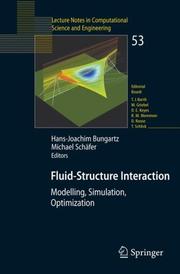
ISBN: 3540345965 9783540345954 1280935723 9786610935727 3540345957 Year: 2006 Publisher: Berlin, Heidelberg : Springer Berlin Heidelberg : Imprint: Springer,
Abstract | Keywords | Export | Availability | Bookmark
 Loading...
Loading...Choose an application
- Reference Manager
- EndNote
- RefWorks (Direct export to RefWorks)
Fluid-structure interactions (FSI), that is interactions of some movable or deformable structure with an internal or surrounding fluid flow, are among the most important and, with respect to both modelling and computational issues, the most challenging multi-physics problems. The variety of FSI occurrences is abundant and ranges from tent-roofs to micropumps, from parachutes via airbags to blood flow in arteries. This volume of LNCSE contains a collection of papers presented at the International Workshop on FSI held in October 2005 in Hohenwart and organized by DFG's Research Unit 493 "FSI: Modelling, Simulation, and Optimization". The papers address partitioned and monolithic coupling approaches, methodical issues and applications, and discuss FSI from the mathematical, informatical, and engineering point of view.
Fluid-structure interaction --- 51-74 --- 519.63 --- 681.3 *G18 --- 681.3*I61 --- Structure-fluid interaction --- Fluid dynamics --- Structural dynamics --- 681.3 *G18 Partial differential equations: difference methods; elliptic equations; finite element methods; hyperbolic equations; method of lines; parabolic equations (Numerical analysis) --- Partial differential equations: difference methods; elliptic equations; finite element methods; hyperbolic equations; method of lines; parabolic equations (Numerical analysis) --- 681.3*I61 Simulation theory: model classification; continuous simulation; discrete simulation (Simulation and modeling) --- Simulation theory: model classification; continuous simulation; discrete simulation (Simulation and modeling) --- 519.63 Numerical methods for solution of partial differential equations --- Numerical methods for solution of partial differential equations --- Mathematical models --- Mathematics in engineering science and technology --- Engineering. --- Construction --- Industrial arts --- Technology --- Hydraulic engineering. --- Computer science. --- Engineering mathematics. --- Cardiology. --- Engineering Fluid Dynamics. --- Computational Science and Engineering. --- Theoretical, Mathematical and Computational Physics. --- Mathematical and Computational Engineering. --- Heart --- Internal medicine --- Engineering --- Engineering analysis --- Mathematical analysis --- Informatics --- Science --- Engineering, Hydraulic --- Fluid mechanics --- Hydraulics --- Shore protection --- Diseases --- Mathematics --- Fluid mechanics. --- Computer mathematics. --- Mathematical physics. --- Applied mathematics. --- Physical mathematics --- Physics --- Computer mathematics --- Electronic data processing --- Hydromechanics --- Continuum mechanics
| Listing 1 - 10 of 11 | << page >> |
Sort by
|

 Search
Search Feedback
Feedback About
About Help
Help News
News